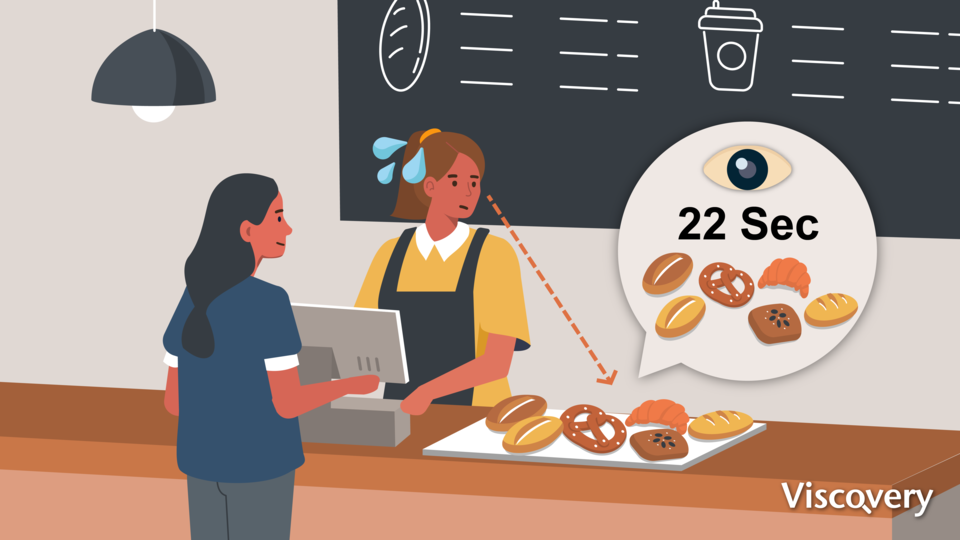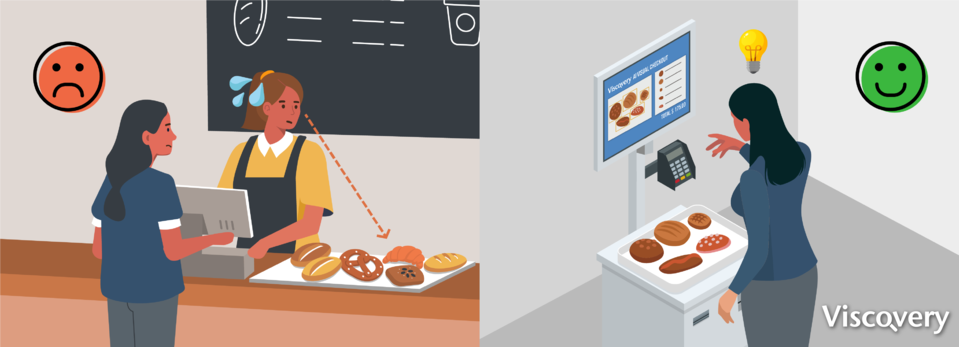
Digital Transformation in Bakeries
How AI Enhances Bakery Operations and Customer Experience
Dec 8, 2023
Bakeries shine with freshly baked goods, all without packaging. As soon as you step into a bakery, the aroma of baking wafts through the air, immersing you in the delightful scent of bread. The golden-brown hue of the baked goods is mouthwatering, and after making your selection, the staff wraps and packages your items at the checkout.
However, the non-pre-packaged bread without a barcode poses a significant challenge to bakeries’ operations.
The Hidden Cost (1) : Checkout Speed
First of all, it affects the checkout speed. Unpackaged bread lacks barcodes for scanning, requiring cashiers to visually identify each item and manually select them on the Point-of-Sale (POS) system. With a wide variety of items, this manual process can be time-consuming, especially during peak hours, leading to longer queues and an unpleasant shopping experience for customers.
A bakery, a client of Viscovery, conducted tests and discovered that a professional cashier could take up to 22 seconds to visually identify six randomly selected bread items. As the number of items increases, the time spent on identification rises, leading to long checkout times and potential service quality issues during busy periods.

The Hidden Cost (2) : Cashier Training
Yet another challenge involves training and operational costs. Cashiers undergo thorough training in product identification, memorizing not just names but also prices.
With high turnover rates in the retail industry—reaching 76% for part-time employees in the U.S. in 2019 1 and escalating 85% in 2022 2 —cashier training expenses skyrocket.
According to Biscuit, a renowned Pâtisserie in Japan, the typical training period lasts two weeks to a month. The investment of time and other training resources can result in substantial losses for businesses if employees quickly leave their positions or consistently struggle with identifying numerous new items.

AI Helps Address Bakeries Pain Points
To tackle these challenges, Viscovery introduced the “AI-powered Visual Checkout” solution. This system leverages the capabilities of artificial intelligence (AI), deep learning, and computer vision to identify non-packaged bread, streamline the checkout process, enhance the customer experience, and reduce both training and operational costs.
Similar to facial recognition, the Viscovery AI system captures images of bread through a camera and identify multiple items simultaneously. This approach is more efficient than the traditional manual process, cutting down customer wait times significantly.

Thanks to AI and deep learning, the computer is trained to recognize bread using human-like thinking. As a result, the system can identify bread even when some loaves appear different due to factors such as baking color, ingredient quantities, or slight shape variations.
Cashiers can confidently delegate “bread identification” to AI, reducing training time for new staff and minimizing the likelihood of mistakes in visual identification by humans. The time saved through quick bread recognition allows cashiers to focus on delivering excellent service to customers, enhancing overall efficiency in bakery operations.
Flexible and Versatile AI Tool
The application of Viscovery’s AI Visual Checkout system is highly versatile. It can be operated by cashiers to expedite checkouts or utilized as a self-service option for customers.
Stores can adopt a dual approach, not only enhancing cashier efficiency but also offering a self-checkout system for customers to choose from. It’s worth noting that the benefits of implementing self-checkout are not solely about “speeding up the checkout process” but rather about “improving the consumer experience.”
A large supermarket shared with us, “While self-checkout might not always be quicker than cashier-assisted checkout, it does allow customers to start the checkout process sooner, providing a better experience than waiting in long queues.“

According to a Forbes report, KFC, which has been expanding its deployment of self-checkout systems in recent years, has found that customers using self-checkout feel more at ease compared to using cashier-assisted checkout. This is because there’s no one watching what they’re buying, and they won’t receive any attention from cashiers 3. In fact, McDonald’s shares a similar perspective 4 and has even discovered that customers using self-checkout have an average order value 30% 5 higher than those using cashier-assisted checkout.
Although KFC and McDonald’s belong to the fast-food industry, the trend of self-checkout in the retail sector may be irreversible. Industry ARC research indicates that from 2021 to 2026, the Compound Annual Growth Rate (CAGR) of self-service kiosk systems in the retail industry will reach 7.28% 6.
Pragmatically Tackling Bakery Challenges
Viscovery’s Visual Checkout system is designed to address pain points for retailers, including bakery. The AI system can be seamlessly integrated without the need to replace the existing POS hardware and software in stores. It can also be adopted through APIs.
Viscovery is dedicated to making AI accessible for bakeries, aiming to enhance both the in-store consumer experience and operational efficiency in the baking industry.
Currently, Viscovery’s AI-powered Visual Checkout system is in use at several bakeries and pâtisseries in Japan, Taiwan, and Singapore. For more details, please refer to Visual Checkout, or contact us at marketing@viscovery.com.
[References]
1 “Korn Ferry survey of top US retailers examines employee turnover.” Korn Ferry, 25 Nov. 2019, www.kornferry.com/about-us/press/as-the-holiday-shopping-season-approaches-korn-ferry-survey-of-top-US-retailers-examines-employee-turnover.
2 “Retail Employee Turnover on the Rise.” Korn Ferry, 15 Nov. 2022, https://www.kornferry.com/about-us/press/retail-employee-turnover-on-the-rise.
3 Kelso, Alicia. “How KFC Scales Technologies Across 22,000 Restaurants Around The World.” Forbes Media LLC, 30 May 2019, www.forbes.com/sites/aliciakelso/2019/05/30/how-kfc-scales-technologies-across-21000-restaurants-around-the-world/?sh=7671ff91638f.
4 Hafner, Josh. “McDonald’s: You buy more from touch-screen kiosks than a person. So expect more kiosks.” USA Today, 7 Jun. 2018, www.usatoday.com/story/money/nation-now/2018/06/07/mcdonalds-add-kiosks-citing-better-sales-over-face-face-orders/681196002/.
5 Gavett, Gretchen. “How Self-Service Kiosks Are Changing Customer Behavior. Harvard Business Review.” Harvard Business Review, 11 Mar. 2015, hbr.org/2015/03/how-self-service-kiosks-are-changing-customer-behavior.
6 GetNews. “Interactive Kiosk Market Size Estimated to Surpass $35.8 Billion Mark by 2026.” Digital Journal, 6 May 2021, https://www.digitaljournal.com/pr/5060414.


